5. Hands-on at the ARMI Terminal¶
This tutorial will walk you through some exploration with ARMI on the command line with the goal of exposing you to some of the capabilities and organization of information in the ARMI system.
5.1. Initializing and Exploring the ARMI Model¶
First we need to get some inputs. We built some from scratch in Building input files for a fast reactor and we pick those up and use them here as well:
You can load these inputs using armi’s init function. This will build an Operator, a Reactor, and an Interface Stack full of various interfaces.
[1]:
# you can only configure an app once
import armi
if not armi.isConfigured():
armi.configure(armi.apps.App())
Failed to import psutil; MemoryProfiler will not provide meaningful data.
+===================================================+
| _ ____ __ __ ___ |
| / \ | _ \ | \/ | |_ _| |
| / _ \ | |_) | | |\/| | | | |
| / ___ \ | _ < | | | | | | |
| /_/ \_\ |_| \_\ |_| |_| |___| |
| Advanced Reactor Modeling Interface |
| |
| version 0.2.6 |
| |
+===================================================+
[2]:
o=armi.init(fName="anl-afci-177.yaml");
=========== Settings Validation Checks ===========
=========== Case Information ===========
[info] --------------------- ------------------------------------------------------------
Case Title: anl-afci-177
Case Description: ANL-AFCI-177 CR 1.0 metal core but with HALEU instead of TRU
Run Type: Standard - Operator
Current User: armi
ARMI Location: /home/runner/work/armi/armi/armi
Working Directory: /home/runner/work/armi/armi/doc/tutorials
Python Interpreter: 3.9.16 (main, Dec 8 2022, 11:01:53)
[GCC 11.3.0]
Master Machine: ?
Number of Processors: 1
Date and Time: Thu Feb 9 22:16:10 2023
--------------------- ------------------------------------------------------------
=========== Input File Information ===========
[info] -------------------------------------------------------------------- ------------------------------ ------------
Input Type Path SHA-1 Hash
-------------------------------------------------------------------- ------------------------------ ------------
Case Settings anl-afci-177.yaml 5e5875c322
Blueprints anl-afci-177-blueprints.yaml 04761fb2b3
Included blueprints anl-afci-177-coreMap.yaml 5904530cb2
Geometry MISSING
<Setting shuffleLogic value:anl-afci-177-fuelManagement.py default:> anl-afci-177-fuelManagement.py 622957b035
-------------------------------------------------------------------- ------------------------------ ------------
=========== Reactor Cycle Information ===========
[info] --------------------------- -----------------------------------------------------------------
Reactor Thermal Power (MW): 1000.0
Number of Cycles: 10
Cycle Lengths: 411.11, 411.11, 411.11, 411.11, 411.11, 411.11, 411.11, 411.11,
411.11, 411.11
Availability Factors: 0.9, 0.9, 0.9, 0.9, 0.9, 0.9, 0.9, 0.9, 0.9, 0.9
Power Fractions: [1.0, 1.0], [1.0, 1.0], [1.0, 1.0], [1.0, 1.0], [1.0, 1.0], [1.0,
1.0], [1.0, 1.0], [1.0, 1.0], [1.0, 1.0], [1.0, 1.0]
Step Lengths (days): [184.9995, 184.9995], [184.9995, 184.9995], [184.9995, 184.9995],
[184.9995, 184.9995], [184.9995, 184.9995], [184.9995, 184.9995],
[184.9995, 184.9995], [184.9995, 184.9995], [184.9995, 184.9995],
[184.9995, 184.9995]
--------------------------- -----------------------------------------------------------------
=========== Constructing Reactor and Verifying Inputs ===========
[info] Constructing the `core`
=========== Adding Assemblies to <Core: core id:139802606446720> ===========
[info] Will expand HE, NA, SI, CR, MN, FE, NI, ZR, MO, W elementals to have natural isotopics
[info] Nuclides truncating the burn-chain: DUMP1, LFP40, DUMP2, LFP35, LFP39, LFP41, LFP38
[info] Constructing assembly `inner fuel`
[warn] No component matched Flags.CLAD in <reflector block-bol-000 at ExCore XS: A BU GP: A>. Returning None
[warn] Some component was missing in <reflector block-bol-000 at ExCore XS: A BU GP: A> so pin-to-duct gap not calculated
[warn] Cannot get pin pitch in <reflector block-bol-000 at ExCore XS: A BU GP: A> because it does not have a wire and a clad
[warn] The gap between wire wrap and clad in block <plenum block-bol-006 at ExCore XS: A BU GP: A> was 3.999999999998449e-05 cm. Expected 0.0.
[info] Constructing assembly `middle core fuel`
[warn] Some component was missing in <reflector block-bol-000 at ExCore XS: B BU GP: A> so pin-to-duct gap not calculated
[warn] Cannot get pin pitch in <reflector block-bol-000 at ExCore XS: B BU GP: A> because it does not have a wire and a clad
[warn] The gap between wire wrap and clad in block <plenum block-bol-006 at ExCore XS: B BU GP: A> was 3.999999999998449e-05 cm. Expected 0.0.
[info] Constructing assembly `outer core fuel`
[warn] Some component was missing in <reflector block-bol-000 at ExCore XS: C BU GP: A> so pin-to-duct gap not calculated
[warn] Cannot get pin pitch in <reflector block-bol-000 at ExCore XS: C BU GP: A> because it does not have a wire and a clad
[warn] The gap between wire wrap and clad in block <plenum block-bol-006 at ExCore XS: C BU GP: A> was 3.999999999998449e-05 cm. Expected 0.0.
[info] Constructing assembly `radial reflector`
[warn] Some component was missing in <reflector block-bol-000 at ExCore XS: A BU GP: A> so pin-to-duct gap not calculated
[info] Constructing assembly `radial shield`
[warn] Temperature 597.0 out of range (25 to 500) for B4C linear expansion percent
[warn] No component matched Flags.WIRE in <radial shield block-bol-000 at ExCore XS: A BU GP: A>. Returning None
[warn] Cannot get pin pitch in <radial shield block-bol-000 at ExCore XS: A BU GP: A> because it does not have a wire and a clad
[info] Constructing assembly `control`
[warn] Could not create a spatialGrid for block control, multiplicities are not 1 or N they are {1.0}
[info] Constructing assembly `ultimate shutdown`
=========== Verifying Assembly Configurations ===========
=========== Summarizing Source of Material Data for <Core: core id:139802606446720> ===========
[info] --------------- ----------------- ----------------------------
Material Name Source Location Property Data was Modified
from the Source?
--------------- ----------------- ----------------------------
B4C ARMI False
HT9 ARMI False
Sodium ARMI False
UZr ARMI False
Void ARMI False
--------------- ----------------- ----------------------------
=========== Applying Geometry Modifications ===========
[info] Resetting the state of the converted reactor core model in <EdgeAssemblyChanger>
[info] Updating spatial grid pitch data for hex geometry
=========== Initializing Mesh, Assembly Zones, and Nuclide Categories ===========
[info] Nuclide categorization for cross section temperature assignments:
------------------ -----------------------------------------------------------
Nuclide Category Nuclides
------------------ -----------------------------------------------------------
Fuel U235, ZR91, AM242M, ZR96, LFP38, NP238, PU236, U238, LFP40,
AM241, PU238, AM243, HE4, PU239, CM245, CM246, CM247, ZR94,
LFP41, CM242, PU242, U236, DUMP1, ZR90, U234, LFP35,
DUMP2, CM244, NP237, PU241, ZR92, LFP39, CM243, PU240
Coolant NA23
Structure SI28, NI64, FE58, MO97, MO92, MO100, CR52, MO94,
B10, NI61, SI30, W184, FE54, NI58, CR50, W182,
FE57, V, MO95, W183, FE56, C, B11, NI62,
MO98, MO96, CR54, SI29, MN55, CR53, NI60, W186
------------------ -----------------------------------------------------------
=========== Creating Interfaces ===========
=========== Interface Stack Summary ===========
[info] ------- ------------------------ --------------- ---------- --------- ----------- ------------
Index Type Name Function Enabled EOL order BOL forced
------- ------------------------ --------------- ---------- --------- ----------- ------------
01 Main main Yes Reversed No
02 FissionProductModel fissionProducts Yes Normal No
03 CrossSectionGroupManager xsGroups Yes Normal No
04 FuelHandler fuelHandler Yes Normal No
05 HistoryTracker history Yes Normal No
06 Report report Yes Normal No
07 Database database Yes Normal No
08 MemoryProfiler memoryProfiler Yes Normal No
09 Snapshot snapshot Yes Normal No
------- ------------------------ --------------- ---------- --------- ----------- ------------
=========== Triggering Init Event ===========
=========== 01 - main Init ===========
=========== 02 - fissionProducts Init ===========
=========== 03 - xsGroups Init ===========
=========== 04 - fuelHandler Init ===========
=========== 05 - history Init ===========
=========== 06 - report Init ===========
=========== 07 - database Init ===========
=========== 08 - memoryProfiler Init ===========
=========== 09 - snapshot Init ===========
=========== Completed Init Event ===========
You have now created an operator object, which contains a Reactor object (called o.r) that
represents the beginning-of-life (BOL) state of the nuclear reactor defined in the inputs. The reactor looks
like this:
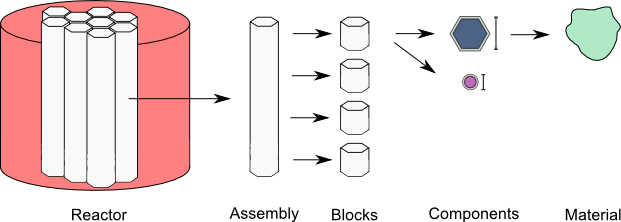
Figure 1. The primary data containers in ARMI¶
The data hierarchy in an ARMI model often is made up of:
Reactors, often namedreactororrcontain a Core and possibly other equipment. They represent collections of assemblies.Assemblies, often namedassemblyora, are individual pieces that collect into a System.Blocks, often calledblockorbare divisions of the assemblies into sections one on top of the other.ComponentsThe geometrically defined objects (Circles, Hexagons, Helices, Dodecagons) and their dimensions.Materialsare objects which have material properties like linear expansion coefficients, thermal conductivities, isotopic mass fractions, and densities.
Each of these objects house more than the listed objects, they also are responsible for a variety of state information like the reactor’s overall keff, flux, height, temperature, etc. In this section, we will explore these objects, see how to access them, and how to view their contained information.
Exploring it a little, we can list all the assemblies in the reactor with:
[3]:
core = o.r.core
core.getAssemblies()[:25] # only print the first 25
[3]:
[<radial shield Assembly A0012 at 011-056>,
<radial reflector Assembly A0011 at 009-045>,
<radial reflector Assembly A0017 at 010-051>,
<radial shield Assembly A0023 at 011-057>,
<control Assembly A0010 at 007-034>,
<outer core fuel Assembly A0016 at 008-040>,
<radial reflector Assembly A0022 at 009-046>,
<radial reflector Assembly A0028 at 010-052>,
<radial shield Assembly A0034 at 011-058>,
<middle core fuel Assembly A0009 at 005-023>,
<middle core fuel Assembly A0015 at 006-029>,
<outer core fuel Assembly A0021 at 007-035>,
<outer core fuel Assembly A0027 at 008-041>,
<radial reflector Assembly A0033 at 009-047>,
<radial reflector Assembly A0040 at 010-053>,
<radial shield Assembly A0046 at 011-059>,
<inner fuel Assembly A0008 at 003-012>,
<middle core fuel Assembly A0014 at 004-018>,
<middle core fuel Assembly A0020 at 005-024>,
<middle core fuel Assembly A0026 at 006-030>,
<outer core fuel Assembly A0032 at 007-036>,
<outer core fuel Assembly A0039 at 008-042>,
<radial reflector Assembly A0045 at 009-048>,
<radial shield Assembly A0052 at 010-054>,
<inner fuel Assembly A0007 at 001-001>]
Quiz Question 1
How many assemblies does the model have? (see answers at bottom)
Tip
A reactor is made up of assemblies, which are made up of blocks, and so on. Each composite ARMI
object has a getChildren method that will retrieve a list of its contents. For clarity,
reactors have a getAssemblies() method and assemblies have a getBlocks() method,
but these do exactly the same thing as getChildren() in both cases.
Reactor, assembly, blocks, etc. objects act like lists as well, so you can get the fifth assembly out of a reactor just like you’d get the fifth item out of any other list (don’t forget that Python uses zero-based numbering):
>>> fifthAssem = core[4]
You can drill down the hierarchy for a particular assembly:
[4]:
core = o.r[0]
print(core)
assem = core[1]
print(assem)
block = assem[5]
print(block)
print(f"Block's parent is: {block.parent}")
components = block.getChildren()
print(components)
material = components[0].material
print(material)
<Core: core id:139802606446720>
<inner fuel Assembly A0008 at 003-012>
<fuel B0008-005 at 003-012-005 XS: A BU GP: A>
Block's parent is: <inner fuel Assembly A0008 at 003-012>
[<Circle: clad>, <Helix: wire>, <Circle: fuel>, <Circle: bond>, <Hexagon: duct>, <Hexagon: intercoolant>, <DerivedShape: coolant>]
<Material: HT9>
5.2. Exploring the state of the reactor¶
State can be explored using a variety of framework methods, as well as looking at state parameters. Let’s first try out some methods to find out how much U-235 is in the model and what the average uranium enrichment is:
[5]:
u235 = core.getMass('U235')
u238 = core.getMass('U238')
print(f"The core contains {u235} grams of U-235")
print(f"The average fissile enrichment is {u235/(u235+u238)}")
The core contains 913110.7780886305 grams of U-235
The average fissile enrichment is 0.16152980132450329
That’s how much U-235 is in the 1/3 core. If we want the total mass (including all nuclides), we can just leave the argument out:
[6]:
core.getMass()/1.e6
[6]:
27.630279585150177
[7]:
core.getMass?
Furthermore, you can get a list of available methods by pressing the tab key. Try core. followed by [Tab]. Try out some options!
Use tab completion to explore other methods of ARMI reactors assemblies and blocks. You can
view a summary of the methods of any object in the API documentation.
For a good example, see the API docs for a block.
Next, lets find out what the number density of U235 is in a particular fuel block. We’ll use the FLAGS system to select a particular type of block (in this case, a fuel block):
[8]:
from armi.reactor.flags import Flags
b = core.getFirstBlock(Flags.FUEL)
print(f"U-235 ndens: {b.getNumberDensity('U235'):.4e} (atoms/bn-cm)")
print(f"Block name: {b.getName()}")
print(f"Block type: {b.getType()}")
U-235 ndens: 2.2592e-03 (atoms/bn-cm)
Block name: B0016-001
Block type: fuel
You can find lots of other details about this block with:
[9]:
b.printContents(includeNuclides=False)
[impt] <fuel B0016-001 at 008-040-001 XS: C BU GP: A>
[impt] <Circle: clad>
[impt] ---------------------------------------------------------------------------------------------
Cladding Dimensions - Of First Fuel Block
Tcold (25.0) Thot (450.0)
---------------------------------------------------------------------------------------------
Inner Diameter (cm) 0.6962 0.6996347645979837
Material HT9
Multiplicity 271 271
Name clad
Outer Diameter (cm) 0.808 0.8119863398379357
Thickness (cm) 0.0559000 0.0561758
[impt] <Helix: wire>
[impt] ---------------------------------------------------------------------------------------------
Wire Dimensions - Of First Fuel Block
Tcold (25.0) Thot (450.0)
---------------------------------------------------------------------------------------------
Axial Pitch (cm) 30.0 30.148007667250084
Helix Diameter (cm) 0.8888 0.8931849738217292
Inner Diameter (cm) 0.0 0.0
Material HT9
Multiplicity 271 271
Name wire
Outer Diameter (cm) 0.0808 0.08119863398379355
[impt] <Circle: fuel>
[impt] ---------------------------------------------------------------------------------------------
Fuel Dimensions - Of First Fuel Block
Tcold (25.0) Thot (500.0)
---------------------------------------------------------------------------------------------
Inner Diameter (cm) 0.0 0.0
Material UZr
Multiplicity 271 271
Name fuel
Outer Diameter (cm) 0.6029 0.6086118601525807
[impt] <Circle: bond>
[impt] ---------------------------------------------------------------------------------------------
Bond Dimensions - Of First Fuel Block
Tcold (447.0) Thot (447.0)
---------------------------------------------------------------------------------------------
Inner Diameter (cm) 0.6029 0.6086118601525807
Material Sodium
Multiplicity 271 271
Name bond
Outer Diameter (cm) 0.6962 0.6996347645979837
Thickness (cm) 0.0466500 0.0455115
[impt] <Hexagon: duct>
[impt] ---------------------------------------------------------------------------------------------
Duct Dimensions - Of First Fuel Block
Tcold (25.0) Thot (450.0)
---------------------------------------------------------------------------------------------
Inner Pitch (cm) 14.922 14.995619013690193
Material HT9
Multiplicity 1.0 1.0
Name duct
Outer Pitch (cm) 15.71 15.787506681749962
Thickness (cm) 0.3940000 0.3959438
[impt] <Hexagon: intercoolant>
[impt] ---------------------------------------------------------------------------------------------
Intercoolant Dimensions - Of First Fuel Block
Tcold (450.0) Thot (450.0)
---------------------------------------------------------------------------------------------
Inner Pitch (cm) 15.71 15.787506681749962
Material Sodium
Multiplicity 1.0 1.0
Name intercoolant
Outer Pitch (cm) 16.142 16.142
Thickness (cm) 0.2160000 0.1772467
[impt] <DerivedShape: coolant>
[impt] ---------------------------------------------------------------------------------------------
Coolant Dimensions - Of First Fuel Block
Tcold (450.0) Thot (450.0)
---------------------------------------------------------------------------------------------
Material Sodium
Name coolant
5.3. Modifying the state of the reactor¶
Each object in the Reactor model has a bunch of state parameters contained in its special .p attribute, called its Parameter Collection. The state parameters are defined both by the ARMI framework and the collection of plugins. For instance, you can look at the core’s keff parameters or each individual block’s power and multi-group flux parameters like this:
[10]:
print(b.p.power)
print(core.p.keff)
print(b.p.mgFlux)
0.0
0.0
None
As you might expect, the values are zero because we have not performed any physics calculations yet. We could run a physics plugin at this point to add physics state, but for this tutorial, we’ll just apply dummy data. Here’s a fake physics kernel that just sets a power distribution based on spatial location of each block (e.g. a spherical distribution):
[11]:
import numpy as np
midplane = core[0].getHeight()/2.0
center = np.array([0,0,midplane])
peakPower = 1e6
mgFluxBase = np.arange(5)
def setFakePower(core):
for a in core:
for b in a:
vol = b.getVolume()
coords = b.spatialLocator.getGlobalCoordinates()
r = np.linalg.norm(abs(coords-center))
fuelFlag = 10 if b.isFuel() else 1.0
b.p.power = peakPower / r**2 * fuelFlag
b.p.pdens = b.p.power/vol
b.p.mgFlux = mgFluxBase*b.p.pdens
setFakePower(core)
[12]:
print(b.p.power)
print(b.p.pdens)
381.5754294076418
0.08321687067850306
[13]:
import matplotlib.pyplot as plt
a = b.parent
z = [b.spatialLocator.getGlobalCoordinates()[2] for b in a]
power = a.getChildParamValues('power')
plt.plot(z,power,'.-')
plt.title("Fake power distribution on reactor")
[13]:
Text(0.5, 1.0, 'Fake power distribution on reactor')
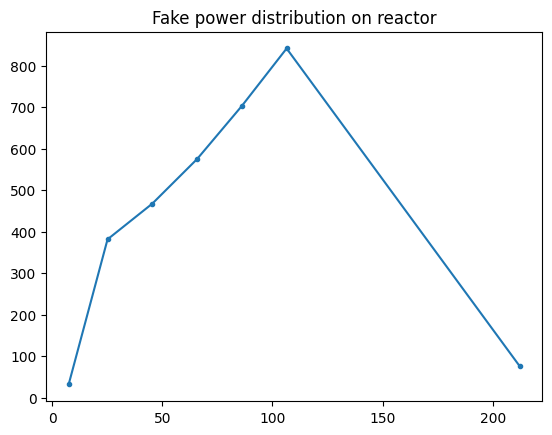
We can take a look at the spatial distribution as well:
[14]:
from armi.utils import plotting
# Note, if you were plotting outside jupyter, you could click
# on different depths at the bottom to view different axial planes.
plotting.plotBlockDepthMap(core, "power", depthIndex=5)
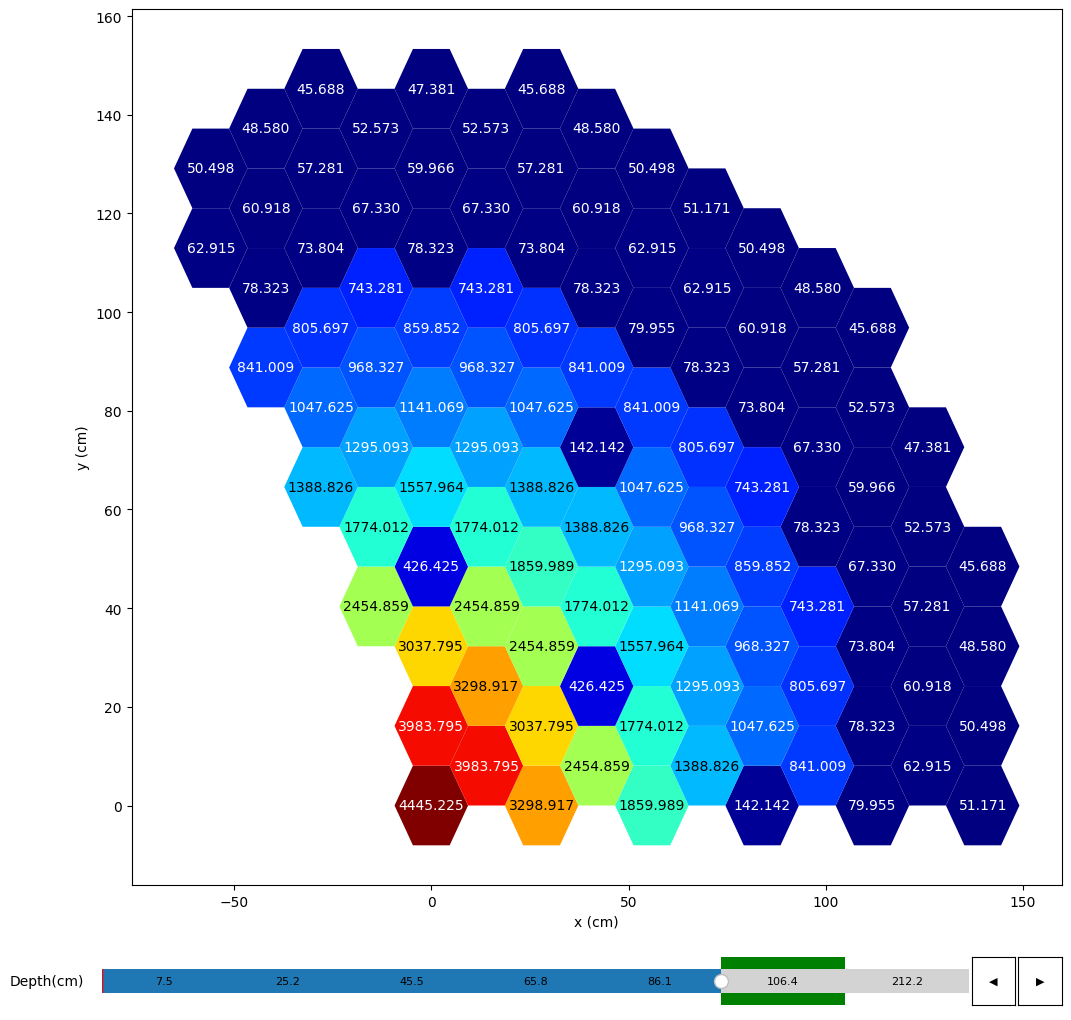
5.4. Modifying number densities¶
Analysts frequently want to modify number densities. For example, if you needed to compute a coolant density coefficient, you could simply reduce the amount of coolant in the core.
[15]:
sodiumBefore = core.getMass('NA')
print(f"Before: {sodiumBefore/1e6:.2f} MT Sodium")
for b in core.getBlocks(): # loop through all blocks
refDens = b.getNumberDensity('NA23')
b.setNumberDensity('NA23',refDens*0.98) # reduce Na density by 2%
sodiumAfter = core.getMass('NA')
print(f"After: {sodiumAfter/1e6:.2f} MT Sodium")
Before: 2.48 MT Sodium
After: 2.43 MT Sodium
If you analyze the keff with a physics plugin before and after, the change in the core.p.keff param would determine your density coefficient of reactivity.
5.5. Saving state to disk¶
During analysis, it’s often useful to save the reactor state to disk in a database. The ARMI database package handles this, and writes it out to an HDF-formatted file. This is typically done automatically at each point in time in a normal simulation, and can also be done manually, like this:
[16]:
dbi = o.getInterface("database")
dbi.initDB()
dbi.database.writeToDB(o.r)
[info] Opening database file at /home/runner/.armi/0-20230209221612740443/anl-afci-177.h5
[info] Writing to database for statepoint: /c00n00
5.6. Fuel management¶
One plugin that comes with the framework is the Fuel Handler. It attaches the Fuel Handler interface, which we can grab now to move fuel around. In a typical ARMI run, the detailed fuel management choices are specified by the user-input custom shuffle logic file. In this particular example, we will simply swap the 10 highest-power fuel assemblies with the 10 lowest-power ones.
[17]:
from armi.physics.fuelCycle import fuelHandlers
fh = fuelHandlers.fuelHandlerFactory(o)
[18]:
moved = []
for n in range(10):
high = fh.findAssembly(param="power", compareTo=1.0e6, blockLevelMax=True, exclusions=moved)
low = fh.findAssembly(param="power", compareTo=0.0, blockLevelMax=True, exclusions=moved)
fh.swapAssemblies(high, low)
moved.extend([high, low])
[19]:
plotting.plotBlockDepthMap(core, "power", depthIndex=5)
# You can also plot total assembly params, which are the sum of block params
plotting.plotFaceMap(core, "power", vals='sum')
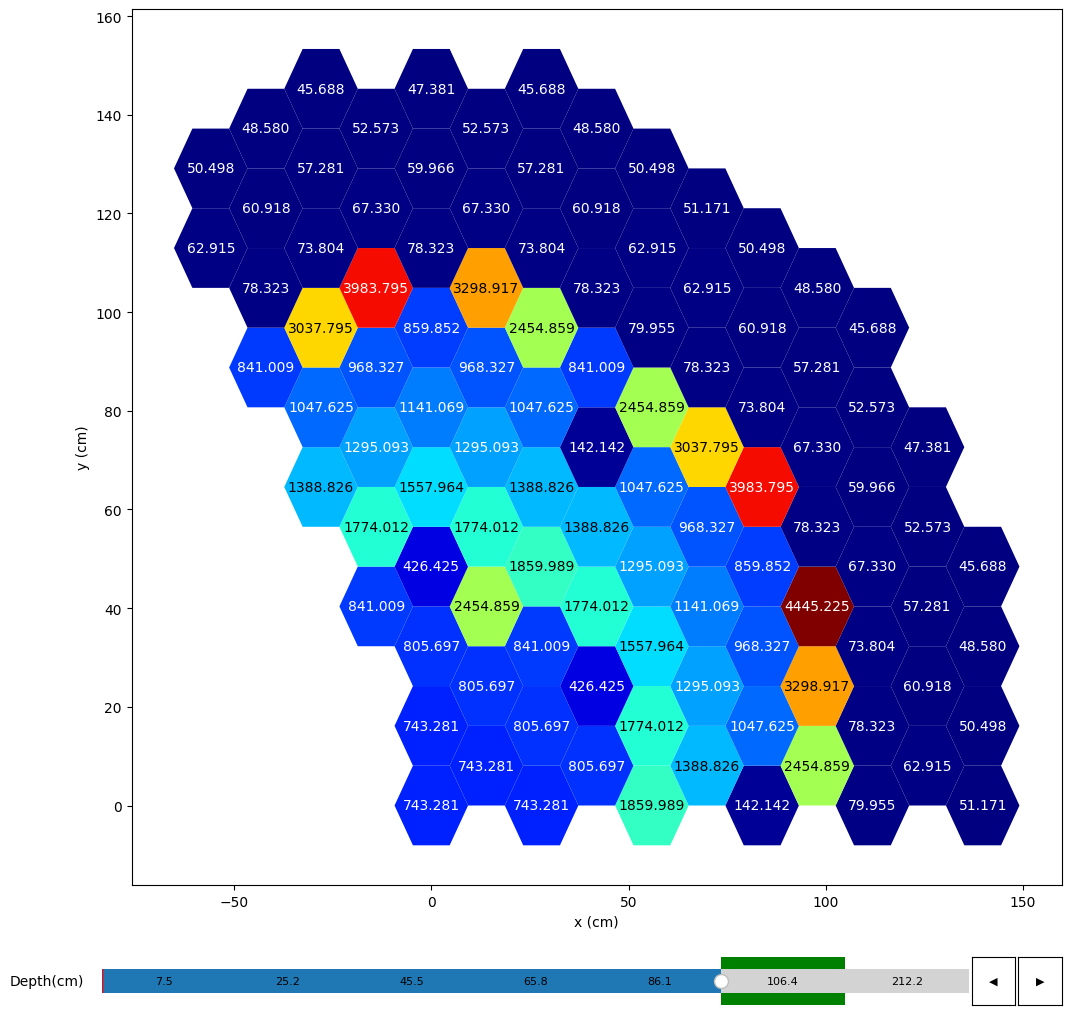
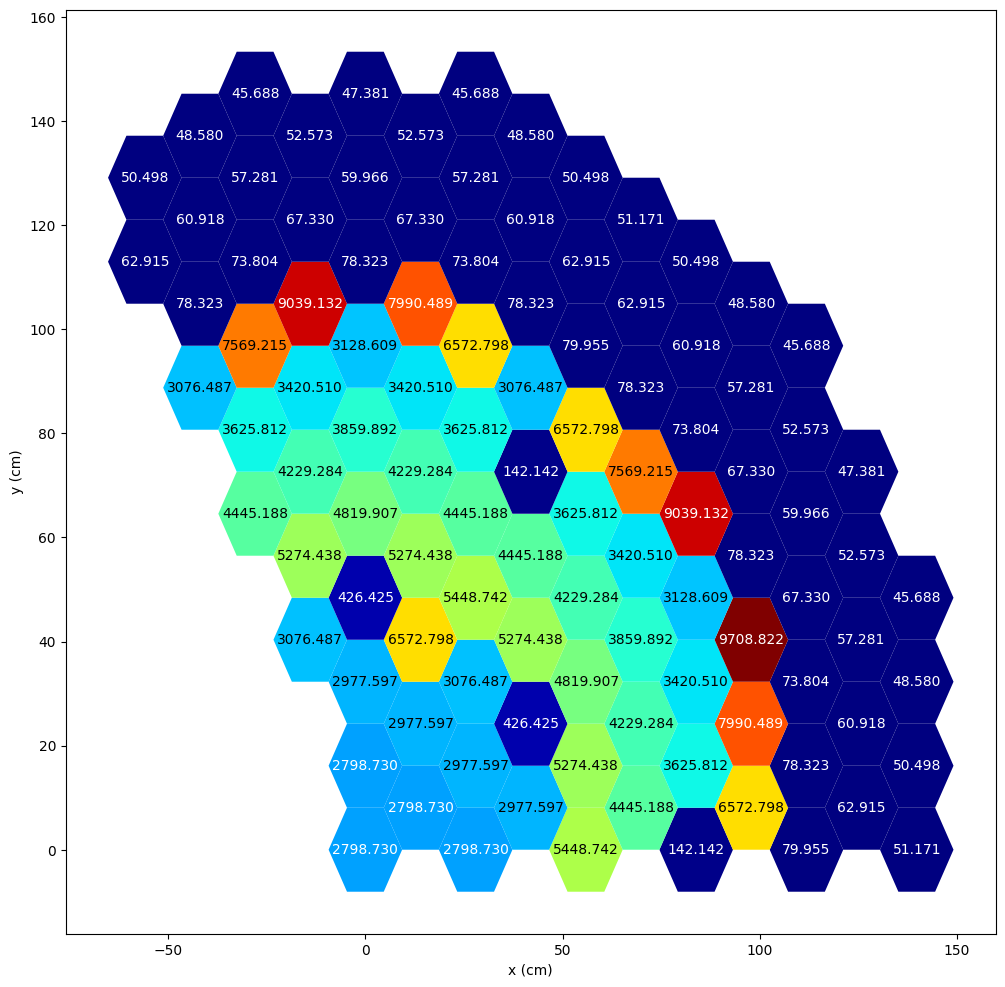
We can write this new state to DB as well, since we’ve shuffled the fuel
[20]:
o.r.p.timeNode +=1
dbi.database.writeToDB(o.r)
dbi.database.close()
[info] Writing to database for statepoint: /c00n01
5.7. Loading from the database¶
Once you have a database, you can use it to load a Reactor object from any of the states that were written to it. First, create a Database3 object, then open it and call its load() method.
[21]:
from armi.bookkeeping import db
databaseLocation = "anl-afci-177.h5"
cycle, timeNode = 0, 1
dbo = db.databaseFactory(databaseLocation, "r")
with dbo:
# Load a new reactor object from the requested cycle and time node
r = dbo.load(cycle, timeNode)
[info] Loading reactor state for time node (0, 1)
[info] Applying <Migration from 0.1.2: Removes now-invalid `centers:` lines fro...
[info] Removing `centers:` sections.
[info] Applying <Migration from 0.1.2: Update elemental nuclide flags....
=========== Initializing Mesh, Assembly Zones, and Nuclide Categories ===========
[info] Will expand HE, NA, SI, CR, MN, FE, NI, ZR, MO, W elementals to have natural isotopics
[info] Constructing assembly `inner fuel`
[warn] Some component was missing in <reflector block-bol-000 at ExCore XS: A BU GP: A> so pin-to-duct gap not calculated
[info] Constructing assembly `middle core fuel`
[warn] Some component was missing in <reflector block-bol-000 at ExCore XS: B BU GP: A> so pin-to-duct gap not calculated
[info] Constructing assembly `outer core fuel`
[warn] Some component was missing in <reflector block-bol-000 at ExCore XS: C BU GP: A> so pin-to-duct gap not calculated
[info] Constructing assembly `radial reflector`
[warn] Some component was missing in <reflector block-bol-000 at ExCore XS: A BU GP: A> so pin-to-duct gap not calculated
[info] Constructing assembly `radial shield`
[info] Constructing assembly `control`
[info] Constructing assembly `ultimate shutdown`
=========== Verifying Assembly Configurations ===========
[info] Nuclide categorization for cross section temperature assignments:
------------------ ------------------------------------------------------------
Nuclide Category Nuclides
------------------ ------------------------------------------------------------
Fuel U235, AM242M, ZR91, ZR96, LFP38, NP238, PU236, AM241, LFP40,
U238, PU238, AM243, HE4, PU239, CM245, CM246, CM247, ZR94,
CM242, LFP41, PU242, U236, DUMP1, ZR90, DUMP2, LFP35,
U234, CM244, NP237, PU241, ZR92, LFP39, CM243, PU240
Coolant NA23
Structure SI28, NI64, FE58, MO97, MO100, MO92, CR52, MO94,
B10, NI61, SI30, W184, FE54, NI58, CR50, W182,
FE57, V, MO95, W183, FE56, C, B11, NI62,
MO98, MO96, CR54, SI29, MN55, CR53, NI60, W186
------------------ ------------------------------------------------------------
We can see that the time node is what we expect (node 1), and there is some fission product mass since we loaded from a cycle after a depletion step.
[22]:
print(r.p.timeNode)
print(o.r.getFissileMass())
1
909142.5216630073
Having a Reactor object by itself can be very useful for all sorts of post-processing tasks. However, sometimes we may wish initialize more ARMI components to do more advanced tasks and interactive follow-on analysis. Lucky for us, the database stores the settings that were used to run the case in the first place. We can get them like this:
[23]:
with dbo:
cs = dbo.loadCS()
print(cs["neutronicsKernel"])
With this CaseSettings object, we could create a brand new Case and Operator and do all sorts of magic. This way of interacting with ARMI is rather advanced, and beyond the scope of this tutorial.
That’s just a brief exploration of the data model. Hopefully it helped orient you to the underlying ARMI structure.